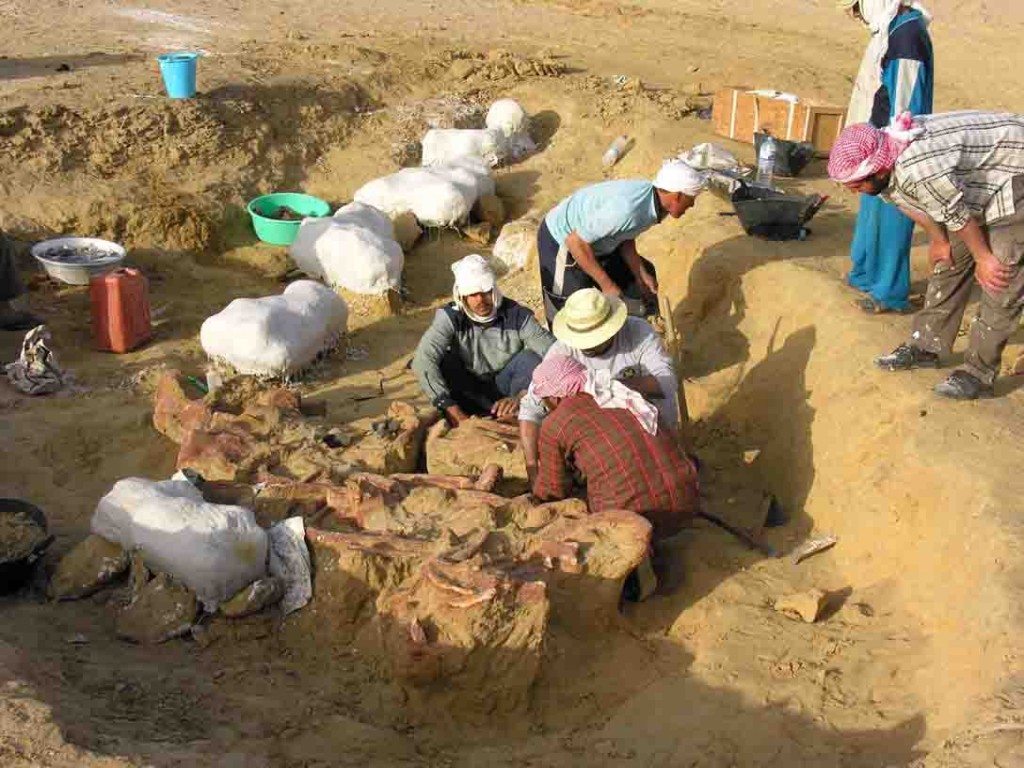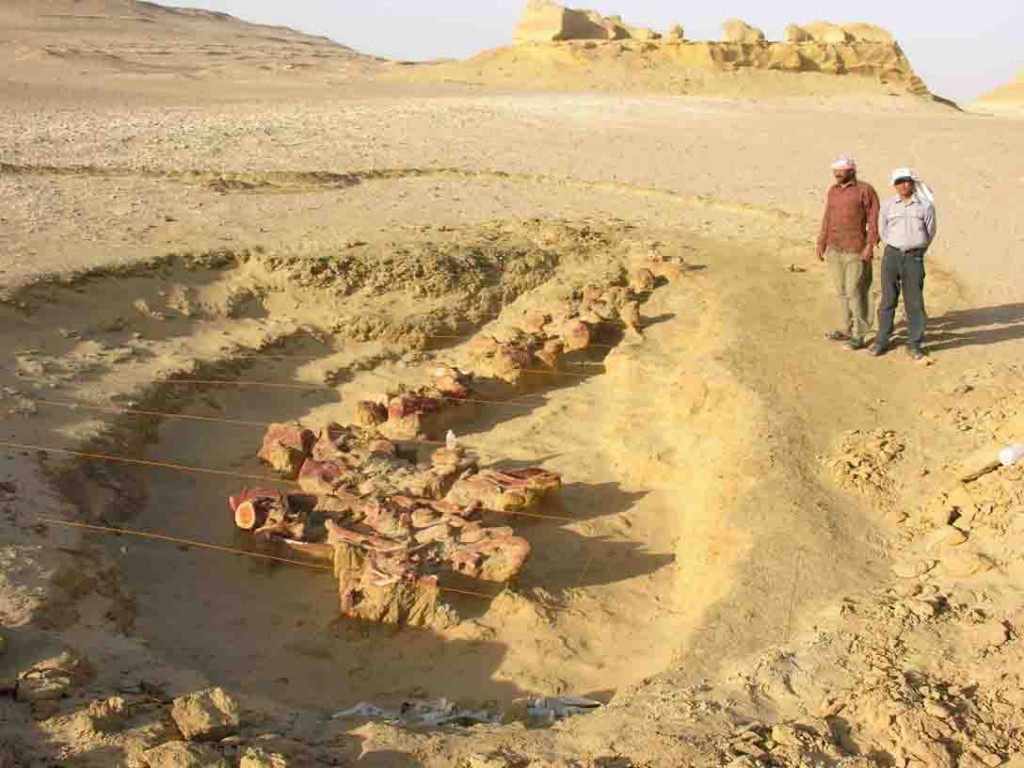
By Paula Hammond
Just beneath the sun scorched sands of the Wadi Al-Hitan lie the bones of creatures whose discovery has added a new and thrilling chapter to the story of evolution.
Say the word ‘Egypt’ and most people will conjure up images of ancient pharaohs and the monuments to their spectacular civilization, that attract millions of visitors every year. However a small but significant number have now abandoned the much-travelled tourist trails, in favour of Egypt’s latest, must-visit destination.
Wadi Al-Hitan, which lies 150 km southwest of Cairo, was designated a World Heritage Site by UNESCO1 in 2005 in acknowledgement of the importance of the region to paleontology. Today, it’s a sand-locked desert valley – so inhospitable, that it’s only since the availability of four-wheel drive, that exploration has become practical. Thirty-seven million years ago though, these same sands were covered by the warm waters of the Tethys Ocean, edged by a lush mangrove lagoon. There, marine creatures fed, mated and died, leaving their bones behind in the mud. Over millennia, the waters receded and the bones were covered by layer upon layer of sediment, which ultimately formed into the region’s epic sandstone cliffs.
Muslim Minds
Wadi Al-Hitan translates as Valley of the Whales. Although the fossilized remains of sharks, sea cows and turtles have all been found there, it’s the region’s ancient whale bones, that have put it on the scientific map. To understand why, we have to go back to the 9th Century.
Charles Darwin is generally considered to be the father of evolutionary theory, but his work was based on many centuries of established scientific observation and commentary. In “On the Origin of Species” Darwin theorized, that animals adapt and change over the course of many generations, in response to their environment and competition for survival. Species with the most useful adaptations survive and pass those new traits onto their offspring. He called this process evolution, “by means of natural selection”. However, such ideas weren’t new: they were already well known in the Muslim world.
In 1874, the scientist John William Draper wrote in his book, “The History of the Conflict Between Religion and Science”, that Western scientists were still far behind their Islamic counterparts in their understanding of “the Mohammedan theory of the evolution of man from lower forms. […] The intellectual movement of Christendom”, he added, had only just “reached that point, which Arabism had attained to in the tenth and eleventh centuries; and doctrines which were then discussed are presenting themselves again for review; such are those of Evolution, Creation, Development…” .2
In fact, in the 9th Century – a thousand years before Darwin’s birth – Iraqi polymath Al-Jahiz3 had written his own theories on evolution. In his book “Kitab al-Hayawan” (“The Book of Animals”), he wrote with great wit and insight, about how animals evolved in response to their environment and competition with other species for survival.
Five hundred years later – and 482 years before Origin of Species was written – Tunis scholar Ibn Khaldun, shared his own thoughts on the topic in his book “Muqaddimah”:
“[…] notice that this world with all the created things in it has a certain order and solid construction. It shows nexuses between causes and things caused, combinations of some parts of creation with others, and transformations of some existent things into others, in a pattern that is both remarkable and endless […] The animal world then widens, its species become numerous, and, in a gradual process of creation, it finally leads to man, who is able to think and to reflect. The higher stage of man is reached from the world of the monkeys, in which both sagacity and perception are found, but which has not reached the stage of actual reflection and thinking .” 4
Why Whales?
It’s thanks to theorists like Al-Jahiz, Ibn Khaldun, and Charles Darwin, that scientists now believe, that life on Earth began in the oceans. It was over 360 million-years-ago, that animals first moved into shallow waters in search of food. Slowly, their fins evolved into legs and their simple lungs became efficient enough to breathe air. It took 300 million years before their ancestors – the mammals – came to dominate the planet. However whales appear to have done an evolutionary u-turn.

Basilosaurus isis fossil whale skeleton excavated in Wadi Hitan, Egypt (image courtesy Professor Gingerich)
Darwin himself struggled to find an explanation for the puzzle posed by whale evolution. These vast, air-breathing leviathans are mammals, like us. Their ancestors must have been land-dwellers, presumably with legs. So why did they return to the oceans and where were the fossils to prove it? This is where the whales of Wadi Al-Hitan enter the story.
Whales have been around for 60 million years but until the 1970s no fossil had been found to link their land-living ancestors and the early ocean-living cetaceans5. Then in 1975, Dr. Philip Gingerich was doing fieldwork in the Khyber Pakhtunkhwa Province of Pakistan, where his team found the bones of what they jokingly dubbed a ‘walking whale’. Further finds in Pakistan and India convinced Gingerich, that his team were onto something. In 1980, they turned their attention to Wadi Al-Hitan. Finally in 1989, they found the first ever knee bone, from an ancient whale species, called Basilosaurus. On the last day of the expedition, paleontologist Holly Smith, found a complete set of inch-long toes. The significance of that find reduced her to tears.
Now that they knew what they were looking for, the team were able to revisit some of their previous excavations in Pakistan. There in 2000, one of Gingerich’s graduate students, Iyad Zalmout, made an equally significant find: an ankle bone among the remains of a 47 million-year-old whale, known as Artiocetus. Seconds later Pakistani geologist, Munir ul-Haq, found another. It was a eureka moment. Although these bones weren’t strong enough to support the whale’s weight, they were evidence that the whale’s ancestors were indeed land-dwellers.
Working the Wadi
When Dr. Gingerich and his team began work in the Wadi Al-Hitan, they were overwhelmed by the sheer scale of fossil finds in the region. But it’s thanks to this vast paleontological storehouse, that we now finally have answers to the great puzzle of whale evolution. We know that hippos and one of the earliest known species of ancient whale6, probably shared a common ancestor. We also finally have a visible ‘link’ between land-dwelling and oceanic whales: Basilosaurus.
Basilosaurus dates from 40-34 million years ago. That’s ten million years after whales left the land. Yet what emerges from the finds so spectacularly preserved in the Wadi’s desert rocks, is a species in transition. These whales were in the last stages of evolution from land to marine mammal, and probably still returned to the shallow waters to mate and bear their young. In April 2005, Dr. Gingerich and his colleagues in the Egyptian Environmental Affairs Agency, announced the successful excavation of the first ever complete Basilosaurus skeleton, meaning that there’s more yet to be learnt from the Wadi’s whales.

Basilosaurus isis fossil whale skeleton excavated in Wadi Hitan, Egypt (image courtesy Professor Gingerich)
Mai El-Amir is a Postgraduate student at the Department of Geology, Mansoura University, whose field of study focuses on the whales of Wadi El-Hitan. “In November 2011”, she says, “I was lucky to be part of a field trip to Wadi El- Hitan organized by Mansoura University Vertebrate Paleontology Center (MUVP) under the supervision of Dr. Hesham Sallam. When my feet touched the ground for the first time, it captured my imagination … When we were arranging our bags to go home, I said to myself ‘I’ve left a part of my soul here. I have to come back again to get it.’ But I’ve found that every time I go to Wadi El-Hitan, I leave another part behind. All of me is in Wadi El-Hitan now!”
Mai is one of a new generation of Muslim scientists, whose passions have been fuelled by this incredible World Heritage Site “I think Wadi El-Hitan is one of the most important places for telling the whale evolution story”, Mai comments. “The importance of the Wadi whales is not just their degree of preservation – which is remarkable – but also because they fill a very important gap in our knowledge of whale evolution. The Wadi whales possessed very small hind limbs, which could not support them on land. What is really magnificent about these nonfunctional limbs is that they make the whole story of evolution more logical and more complete. Why would these giant whales have such small, useless hind limbs unless they were traceable links to their land-living past?”
Evolution is an evolving story. Every new find adds a new chapter to the tale of life on Earth. Muslim scientists were amongst the first to theorize about evolution and the work in the Wadi Al-Hitan continues to inform and inspire those, working in the Muslim world today.
Paula Hammond is a professional author of over 35 non-fiction books, including popular science volumes on fossils, dinosaurs and endangered animals. She has a passion for learning and the wonders of the natural world.
References:
1. United Nations Educational, Scientific and Cultural Organization.
2. Full text can be read at: http://www.gutenberg.org/files/1185/1185-h/1185-h.htm
3. Darwin was born in 1809 and wrote “On the Origin of Species” in 1859. Al-Jahiz was born in 767 and wrote “The Book of Animals” some time after 816. Ibn Khaldun was born in 1332 and wrote “Muqaddimah” in 1377.
4. Full text can be read at: http://www.muslimphilosophy.com/ik/Muqaddimah/
5. An animal group that includes whales, porpoises and dolphins. The name comes from the Greek meaning “huge fish or sea monster”.
6. Artiocetus
You must be logged in to post a comment.